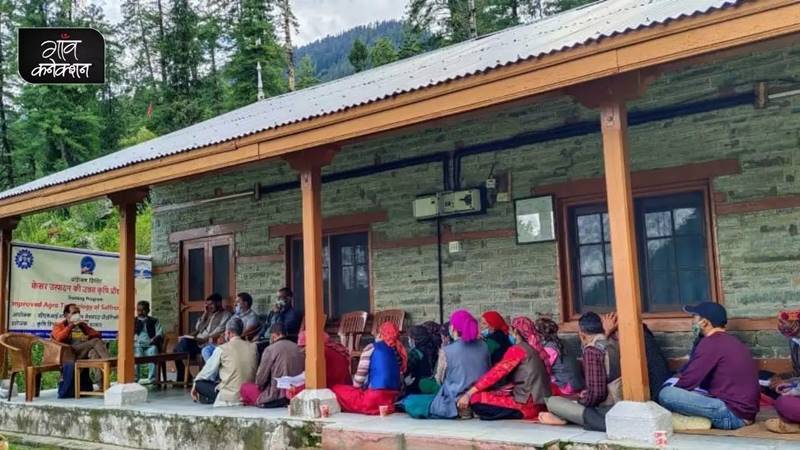Farmers in Himachal Pradesh take to cultivating saffron
Saffron farming, mostly limited to Kashmir, has now commenced in the districts of Kinnaur, Chamba, Mandi, Kullu, and Kangra in Himachal Pradesh. The climate in these districts is ideal for ‘kesar’ cultivation and the CSIR-Institute of Himalayan Bioresource Technology in Palampur, is training the Himachali farmers for it.


Many farmers in the state have replaced their regular crop produce with saffron.
While Kashmir is the undisputed leader of saffron cultivation in India, if not the only one, Himachal Pradesh has just begun to take baby steps in that direction. Saffron farming has recently begun in the Kinnaur, Chamba, Mandi, Kullu, and Kangra districts of the state.
“I have been growing herbs for several years, and when I learned that saffron cultivation training was being provided, I enrolled on the programme quickly,” Dheeraj Kumar, a 40-year-old farmer from Bharmour village in Chamba district, told Gaon Connection. He has cultivated saffron on his one-bigha [0.25 hectare] farm. “I could produce just 10 grams of saffron this time, but I hope to improve my yield in the future,” he said.
A saffron-cultivation training programme was recently organised in Himachal Pradesh by the CSIR-Institute of Himalayan Bioresource Technology (IHBT) in Palampur. Many farmers in the state have replaced their regular crop produce with saffron.

“I have been cultivating organic beans, peas, apples, and walnuts for many years,” Parmeshwar Singh of Mebar village, Kinnaur district, told Gaon Connection. But now the 57-year-old decided to try his hand at growing saffron after he attended the training workshop.
“We first planted saffron in our field, which is at about five thousand feet [1,500 metres above sea level]. But this time we have gone a little higher and planted saffron at eight thousand feet [about 2,400 masl],” Parmeshwar said. He said they hoped this would lead to a better yield.
The Institute of Himalayan Bioresource Technology has teamed up with the state’s Agriculture Department for this project.
Also Read: Now you can bite into crunchy apples from Mizoram and Manipur
“Currently, saffron is only produced in Kashmir in our country. The environment in several areas of Himachal Pradesh is similar to Kashmir and conducive to saffron growing,” Rakesh Kumar, senior principal scientist and project coordinator, IHBT, told Gaon Connection. “We’ve been working on this initiative for over a year, and we’re not only offering training to the farmers but also seeds,” he said.
Training the farmers
As part of the saffron-growing initiative, the Institute has so far trained about 70 farmers.
“We have also imparted training to agriculture development officers, agriculture extension officers and deputy directors of the Himachal Pradesh Agriculture Department who interact with farmers, and select cultivators to distribute seeds,” Rakesh Kumar added.
Also Read: Flower Power: Wild marigold farming opens up new avenues of income for farmers in Himachal Pradesh
Saffron seeds, from IHBT, were distributed through the agriculture department of the state to farmers in Kinnaur, Chamba, Kullu, Mandi, and Kangra districts, who had undergone the training. As a pilot project, saffron seeds were planted on 2.5 acres ( a little more than one hectare) of land indifferent parts of the state, Rakesh Kumar said.

Ideally, saffron is cultivated in regions that are about 1,500-2,800 meters above sea level, where there is snowfall in winters. This is perfectly suitable for flowering, and a superior quality production. September to October is the right time for planting saffron tubers.
The quality and price of saffron are determined by its colour, taste and aroma.
Beyond Kashmir
Saffron is currently cultivated in Pampore, Srinagar, and Kishtwar in the Union Territory of Jammu and Kashmir. According to IHBT, there is a demand for 100 tonnes of saffron per year in India, yet only 6.46 tonnes are produced in 2,825 acres (approximately 1,143 hectares).
Also Read: Why are Iranian apples making Indian farmers angry?
Iran is the world’s leading producer of saffron, with 300 tonnes produced each year. Spain and India are second and third, respectively.
The initiative to cultivate saffron in Himachal Pradesh is a step towards making India self-reliant in saffron production, Sanjay Kumar, director IHBT, told Gaon Connection. He said IHBT was working in tandem with the state’s agriculture department to organise more training programmes for farmers in Himachal Pradesh. According to him, the response from women farmers in the state to the training courses on saffron-cultivation was heartening.
Read the story in Hindi.

